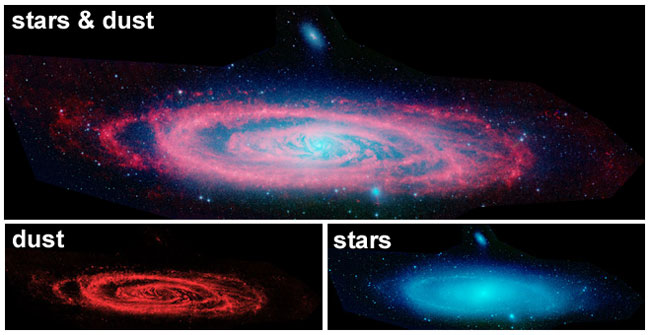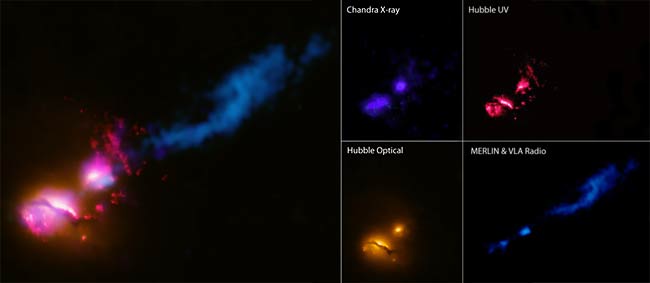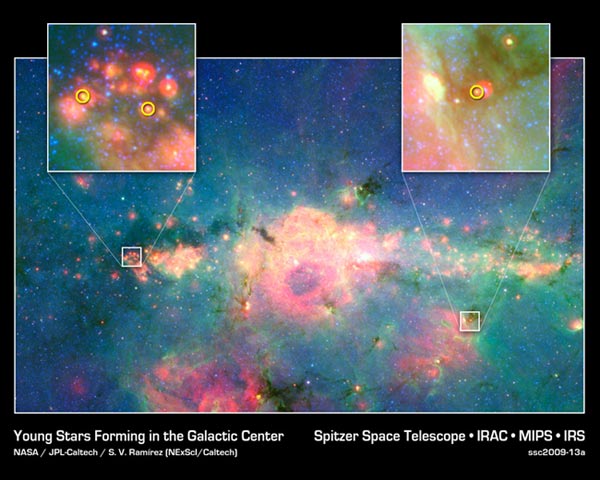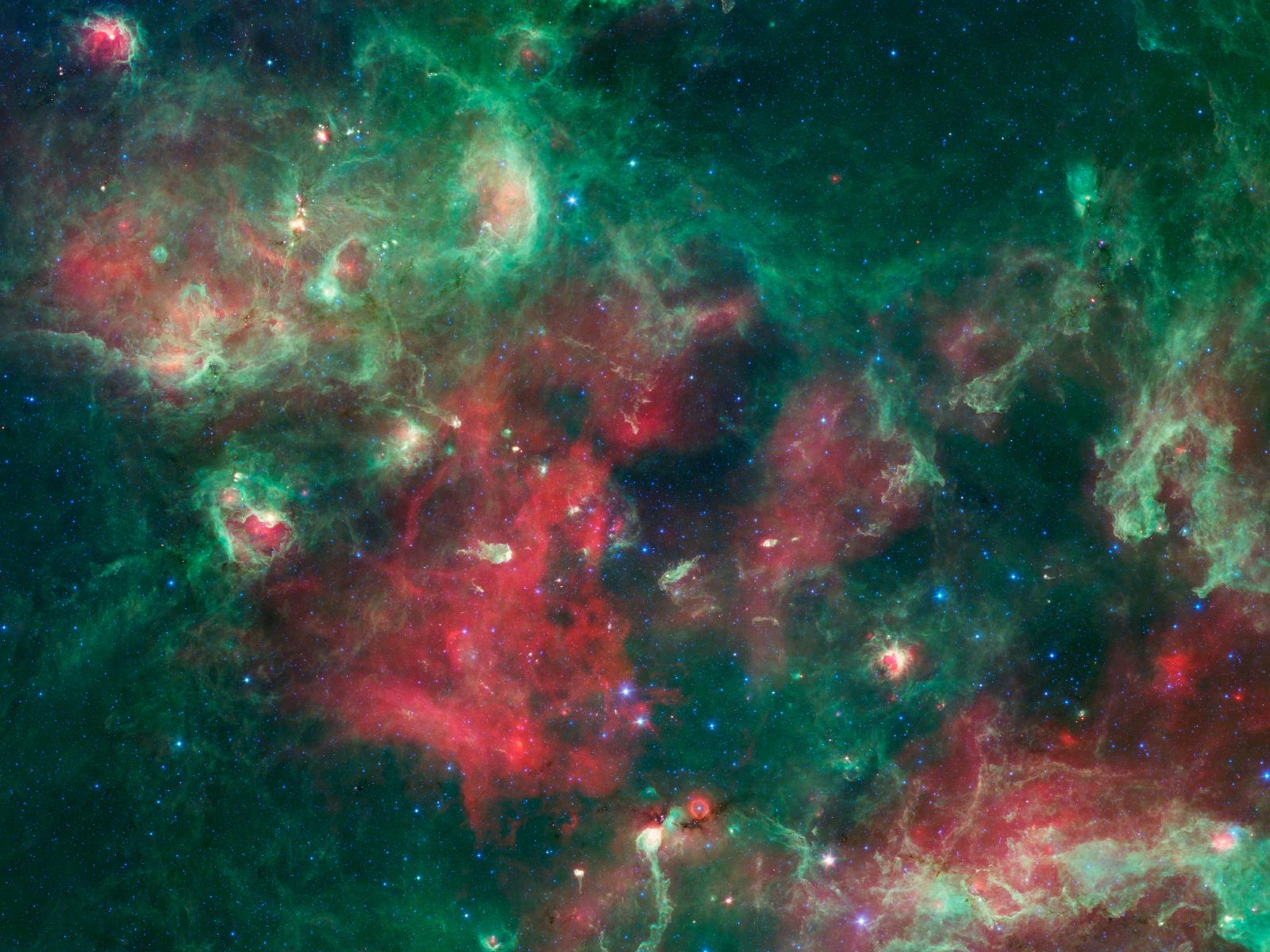Gallery: The infrared universe seen by NASA's Spitzer Space Telescope
North America Nebula
NASA's Spitzer Space Telescope captured this infrared view of the North America nebula in 2011. But where's the continent? Since infrared light can penetrate dust, while visible light cannot, the picture of the nebula that usually resembles the continent of North America changes completely. Dusty, dark clouds in the visible image vanish in Spitzer's view. In addition, Spitzer's infrared detectors display the glow of dusty cocoons enveloping baby stars. Clusters of young stars (about 1 million years old) appear throughout the image.
Related: North America Nebula Burns Bright in Skywatcher Photo
The 'Heart' of the Milky Way
In this spectacular image, observations using infrared light and X-ray light see through the obscuring dust and reveal the intense activity near the galactic core of the Milky Way. The image combines pictures from the Hubble Space Telescope, Spitzer Space Telescope and Chandra X-ray Observatory.
Full Story: 3 Telescopes Combine for Stunning Milky Way Photo
Andromeda Revealed
The top image in this infrared composite shot from NASA's Spitzer Space Telescope highlights the contrast between the Andromeda galaxy's choppy waves of dust (red) and smooth sea of older stars (blue). The panels below the main image show the galaxy's dust (left) and older stars (right) separately.
Full Story: Andromeda Revealed: New Closeups of Our Galactic Neighbor
Galaxy Blasts Neighbor with Deadly Jet
Spitzer captured a powerful jet from a supermassive black hole blasting a nearby galaxy in the system known as 3C321. This galactic violence, never seen before, could have a profound effect on any planets in the path of the jet and trigger a burst of star formation in the wake of its destruction.
Breaking space news, the latest updates on rocket launches, skywatching events and more!
Full Story: Galaxy Blasts Neighbor with Deadly Jet
Spitzer Spots Baby Stars
By using the Spitzer Space Telescope to peer through thick clouds of cosmic gas and dust, astronomers discovered a population of baby stars near the center of the Milky Way galaxy. The yellow circles show the young stars that were detected in the chaotic environment at the Milky Way's center. NASA released the image in 2009.
Full Story: Baby Stars Found in Galactic Center
Spitzer Warms Up
These images are some of the first to be taken during Spitzer's "warm" mission, after the space telescope ran out of coolant. At left is a cloud, known as DR22, bursting with new stars in the Cygnus region of the sky. The picture at upper right shows a relatively calm galaxy called NGC 4145. The final picture at lower right shows a dying star called NGC 4361.
Full Story: Space Telescope Warms Up, Makes Pretty Pictures
Crystal Rain Star
This image taken of the Orion nebula by NASA's infrared Spitzer Space Telescope shows the location of the infant star HOPS-68, which a 2011 study reveals is subjected to a crystal rain of olivine minerals.
Full Story: Star's Green Crystal 'Rain' May Solve Comet Mystery
A Dusty Magellanic Cloud
This image shows the Large Magellanic Cloud galaxy in infrared light as seen by NASA's Spitzer Space Telescope and the European Space Agency's Herschel Space Observatory. In this combined image, the dwarf galaxy looks like a fiery, circular explosion. However, those ribbons are actually giant ripples of dust spanning tens or hundreds of light-years.
Stars Brewing in Cygnus X
A bubbling cauldron of star birth, Cygnus X, is highlighted in this 2012 image from NASA's Spitzer Space Telescope. Infrared light that we can't see with our eyes has been color-coded, such that the shortest wavelengths are shown in blue and the longest in red. The middle wavelength range is green.
Snowflake Cluster and Cone Nebula
Strange shapes and textures can be found in the neighborhood of the Cone Nebula. These patterns result from the tumultuous unrest that accompanies the formation of the open cluster of stars known as NGC 2264, the Snowflake Cluster. To better understand this process, a detailed image of this region was taken in two colors of infrared light by the orbiting Spitzer Space Telescope. NASA released the image in 2008.
Record-Breaking View of the Milky Way
A section of the largest image of the Milky Way ever created. It was stitched together from 800,000 individual infrared images taken by NASA's Spitzer Space Telescope.
Full Story: World's Largest Milky Way Image Unveiled
Follow us on Twitter @Spacedotcom and on Facebook.


Space.com is the premier source of space exploration, innovation and astronomy news, chronicling (and celebrating) humanity's ongoing expansion across the final frontier. Originally founded in 1999, Space.com is, and always has been, the passion of writers and editors who are space fans and also trained journalists. Our current news team consists of Editor-in-Chief Tariq Malik; Editor Hanneke Weitering, Senior Space Writer Mike Wall; Senior Writer Meghan Bartels; Senior Writer Chelsea Gohd, Senior Writer Tereza Pultarova and Staff Writer Alexander Cox, focusing on e-commerce. Senior Producer Steve Spaleta oversees our space videos, with Diana Whitcroft as our Social Media Editor.











